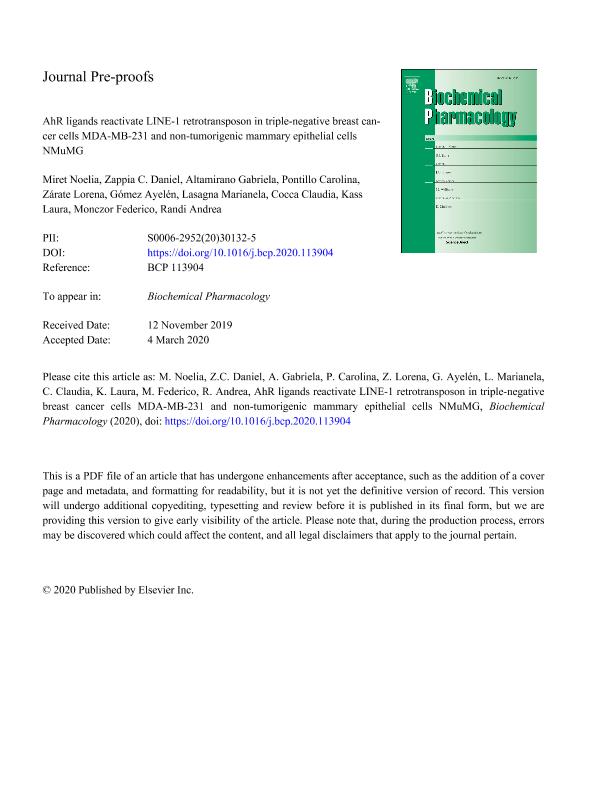Artículo
AhR ligands reactivate LINE-1 retrotransposon in triple-negative breast cancer cells MDA-MB-231 and non-tumorigenic mammary epithelial cells NMuMG
Miret, Noelia Victoria ; Zappia, Carlos Daniel
; Zappia, Carlos Daniel ; Altamirano, Gabriela Anahí
; Altamirano, Gabriela Anahí ; Pontillo, Carolina Andrea
; Pontillo, Carolina Andrea ; Zárate, Lorena Vanesa; Gomez, Ayelen Luciana
; Zárate, Lorena Vanesa; Gomez, Ayelen Luciana ; Lasagna, Marianela
; Lasagna, Marianela ; Cocca, Claudia Marcela
; Cocca, Claudia Marcela ; Kass, Laura
; Kass, Laura ; Monczor, Federico
; Monczor, Federico ; Randi, Andrea Silvana
; Randi, Andrea Silvana
 ; Zappia, Carlos Daniel
; Zappia, Carlos Daniel ; Altamirano, Gabriela Anahí
; Altamirano, Gabriela Anahí ; Pontillo, Carolina Andrea
; Pontillo, Carolina Andrea ; Zárate, Lorena Vanesa; Gomez, Ayelen Luciana
; Zárate, Lorena Vanesa; Gomez, Ayelen Luciana ; Lasagna, Marianela
; Lasagna, Marianela ; Cocca, Claudia Marcela
; Cocca, Claudia Marcela ; Kass, Laura
; Kass, Laura ; Monczor, Federico
; Monczor, Federico ; Randi, Andrea Silvana
; Randi, Andrea Silvana
Fecha de publicación:
05/2020
Editorial:
Pergamon-Elsevier Science Ltd
Revista:
Biochemical Pharmacology
ISSN:
0006-2952
Idioma:
Inglés
Tipo de recurso:
Artículo publicado
Clasificación temática:
Resumen
Breast cancer is the most common cancer type in females worldwide. Environmental exposure to pesticides affecting hormonal homeostasis does not necessarily induce DNA mutations but may influence gene expression by disturbances in epigenetic regulation. Expression of long interspersed nuclear element-1 (LINE-1) has been associated with tumorigenesis in several cancers. In nearly all somatic cells, LINE-1 is silenced by DNA methylation in the 5´UTR and reactivated during disease initiation and/or progression. Strong ligands of aryl hydrocarbon receptor (AhR) activate LINE-1 through the transforming growth factor-β1 (TGF-β1)/Smad pathway. Hexachlorobenzene (HCB) and chlorpyrifos (CPF), both weak AhR ligands, promote cell proliferation and migration in breast cancer cells, as well as tumor growth in rat models. In this context, our aim was to examine the effect of these pesticides on LINE-1 expression and ORF1p localization in the triple-negative breast cancer cell line MDA-MB-231 and the non-tumorigenic epithelial breast cell line NMuMG, and to evaluate the role of TGF-β1 and AhR pathways. Results show that 0.5 μM CPF and 0.005 μM HCB increased LINE-1 mRNA expression through Smad and AhR signaling in MDA-MB-231. In addition, the methylation of the first sites in 5´-UTR of LINE-1 was reduced by pesticide exposure, although the farther sites remained unaffected. Pesticides modulated ORF1p localization in MDA-MB-231: 0.005 μM HCB and 50 μM CPF increased nuclear translocation, while both induced cytoplasmic retention at 0.5 and 5 μM. Moreover, both stimulated double-strand breaks, enhancing H2AX phosphorylation, coincidentally with ORF1p nuclear localization. In NMuMG similar results were observed, since they heighten LINE-1 mRNA levels. CPF effect was through AhR and TGF-β1 signaling, whereas HCB action depends only of AhR. In addition, both pesticides increase ORF1p expression and nuclear localization. Our results provide experimental evidence that HCB and CPF exposure modify LINE-1 methylation levels and induce LINE-1 reactivation, suggesting that epigenetic mechanisms could contribute to pesticide-induced breast cancer progression
Archivos asociados
Licencia
Identificadores
Colecciones
Articulos(ISAL)
Articulos de INSTITUTO DE SALUD Y AMBIENTE DEL LITORAL
Articulos de INSTITUTO DE SALUD Y AMBIENTE DEL LITORAL
Articulos(OCA HOUSSAY)
Articulos de OFICINA DE COORDINACION ADMINISTRATIVA HOUSSAY
Articulos de OFICINA DE COORDINACION ADMINISTRATIVA HOUSSAY
Citación
Miret, Noelia Victoria; Zappia, Carlos Daniel; Altamirano, Gabriela Anahí; Pontillo, Carolina Andrea; Zárate, Lorena Vanesa; et al.; AhR ligands reactivate LINE-1 retrotransposon in triple-negative breast cancer cells MDA-MB-231 and non-tumorigenic mammary epithelial cells NMuMG; Pergamon-Elsevier Science Ltd; Biochemical Pharmacology; 175; 5-2020; 113904-1/14
Compartir
Altmétricas



